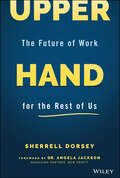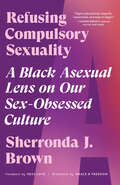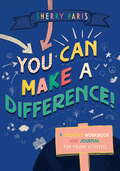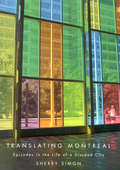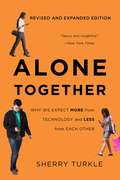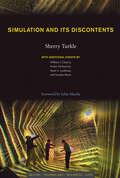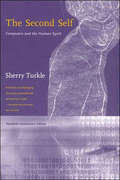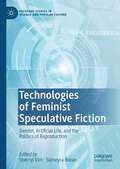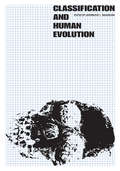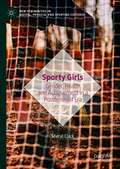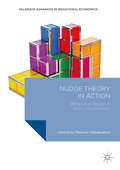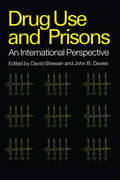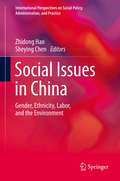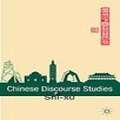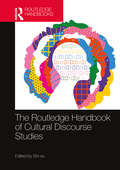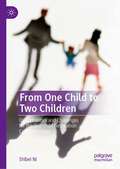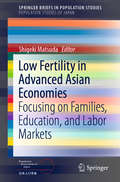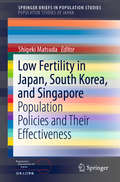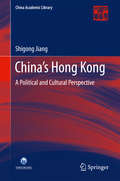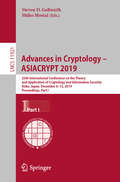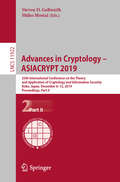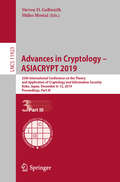- Table View
- List View
Upper Hand: The Future of Work for the Rest of Us
by Sherrell DorseyLearn how to secure a place at the professional table for Black, Latinx, and other marginalized groups In Upper Hand: The Future of Work for the Rest of Us, celebrated Founder and CEO of The Plug, Sherrell Dorsey, delivers a personal and eye-opening exploration of how to ensure that marginalized communities aren't left behind as technology continues its inexorable march forward. In the book, readers will learn to think about how we can strategically shape the coming decade to include Black and Brown communities. Upper Hand offers guidelines, insights, and frameworks for navigating the new world of work that is dominated by Silicon Valley-rooted technologies, inaccessible networks, and constant automation that continues to slash jobs in the Black and Latinx population. You'll find ways to: Help families and community leaders design clear pathways to understanding alternatives to obsolescence Thrive in an ever-changing, tech-driven economy that is beginning to leave people of color behind Embrace new strategies that guarantee a place for Black and brown people in the new economy The startling and insightful discussion in Upper Hand will earn it a place in the libraries of families, teachers, community advocates, workforce development leaders, professionals of color, as well as anyone interested in learning how to distribute the benefits of the new tech economy to those historically left out.
Ties to Tattoos: Turning Generational Differences into a Competitive Advantage (Ties To Tattoos 2nd Edition Ser.)
by Sherri Elliott-Yeary“Capitalizing on the talents of a multigenerational work force is the key to future business success. Sherri Elliott recognizes that and gives sound advice.” —Leslie Elliott, president, Toni & Guy, USAFor the first time in history, the American workforce is comprised of four distinct generations—Traditionalists, Boomers, Xers, and Millennials. Additionally, today’s workforce brings with it a new set of challenges and opportunities: the looming labor shortage, sagging productivity, knowledge transfer, the language barrier, and stereotypes.Ties to Tattoos offers innovative ways to recruit, reward, manage, motivate, train, and retain, all within a generationally diverse workplace. Understanding generational issues is one of the best new tools for resolving conflicts and boosting productivity. Ties to Tattoos provides keys for understanding these issues and strategies to leverage multigenerational differences in ways that make companies stronger. The creative people strategies described throughout the book set the bar for companies in the coming decade with the sustainable competitive advantage engaged and committed employees.“Ties to Tattoos provides thought-provoking realities you need to consider. It affords actionable ideas on how to gain better understanding of what drives today’s workforce to deliver exceptional results.” —George Killebrew, Senior Vice-President of Corporate Sponsorships, Dallas Mavericks“Provides very helpful insights into the nature and reasons for these generational differences and offers strategies for leveraging them to an organization’s advantage. While the commonalities between generations may be much greater than the differences, knowing how to recognize and manage the differences can make the leadership challenge less daunting.” —Susan R. Meisinger, SPHR, past president, Society for Human Resource Management
Refusing Compulsory Sexuality: A Black Asexual Lens on Our Sex-Obsessed Culture
by Sherronda J. BrownFor readers of Ace and Belly of the Beast: A Black queer feminist exploration of asexuality--and an incisive interrogation of the sex-obsessed culture that invisibilizes and ignores asexual and A-spec identity.Everything you know about sex and asexuality is (probably) wrong.The notion that everyone wants sex--and that we all have to have it--is false. It&’s intertwined with our ideas about capitalism, race, gender, and queerness. And it impacts the most marginalized among us. For asexual folks, it means that ace and A-spec identity is often defined by a queerness that&’s not queer enough, seen through a lens of perceived lack: lack of pleasure, connection, joy, maturity, and even humanity.In this exploration of what it means to be Black and asexual in America today, Sherronda J. Brown offers new perspectives on asexuality. She takes an incisive look at how anti-Blackness, white supremacy, patriarchy, heteronormativity, and capitalism enact harm against asexual people, contextualizing acephobia within a racial framework in the first book of its kind. Brown advocates for the &“A&” in LGBTQIA+, affirming that to be asexual is to be queer--despite the gatekeeping and denial that often says otherwise.With chapters on desire, f*ckability, utility, refusal, and possibilities, Refusing Compulsory Sexuality discusses topics of deep relevance to ace and a-spec communities. It centers the Black asexual experience--and demands visibility in a world that pathologizes and denies asexuality, denigrates queerness, and specifically sexualizes Black people.A necessary and unapologetic reclamation, Refusing Compulsory Sexuality is smart, timely, and an essential read for asexuals, aromantics, queer readers, and anyone looking to better understand sexual politics in America.
You Can Make a Difference!: A Creative Workbook and Journal for Young Activists
by Sherry ParisPacked with fun activities for self-reflection and development, this creative workbook is the ultimate toolkit for all young activists looking to make a difference and create change. Each chapter includes voices from inspiring young game changers to encourage readers to channel their passion for social justice into positive action. Focusing on identity, discrimination and oppression, it offers the space to explore new ideas, self-reflect and expand awareness of the systems underpinning injustice. Chapters engage with a range of social justice and identity issues, including race, gender, sexual orientation and disability, providing the tools needed to facilitate and encourage personal growth. Through creative art activities, journal prompts, interviews and more, this workbook will inspire, engage and empower you to realize your own social justice project and put it into action.
Translating Montreal
by Sherry SimonTranslating Montreal follows the trajectories of adventurous cultural translators such as Malcolm Reid, F.R. Scott, and A.M. Klein - pioneers of the 1950s and 1960s - Pierre Anctil, whose translations from Yiddish to French are emblematic of the dramatic reroutings now occurring across the Montreal landscape, and contemporary writer-translators such as Gail Scott, Erin Mouré, Jacques Brault, Michel Garneau, Nicole Brossard, and Emile Ollivier. Simon argues that translation is a dynamic and subtle tool for analysing cultural contact. An original take on cultural relations in the city, Translating Montreal explores the emergence of the "new" Montrealer. No longer "Franco-Québécois," "Anglo-Québécois," "immigrant," or "ethnic," the new Montrealer is a citizen of a mixed and cosmopolitan city.
Translating Montreal: Episodes in the Life of a Divided City
by Sherry SimonTranslating Montreal follows the trajectories of adventurous cultural translators such as Malcolm Reid, F.R. Scott, and A.M. Klein - pioneers of the 1950s and 1960s - Pierre Anctil, whose translations from Yiddish to French are emblematic of the dramatic reroutings now occurring across the Montreal landscape, and contemporary writer-translators such as Gail Scott, Erin Mouré, Jacques Brault, Michel Garneau, Nicole Brossard, and Emile Ollivier. Simon argues that translation is a dynamic and subtle tool for analysing cultural contact. An original take on cultural relations in the city, Translating Montreal explores the emergence of the "new" Montrealer. No longer "Franco-Québécois," "Anglo-Québécois," "immigrant," or "ethnic," the new Montrealer is a citizen of a mixed and cosmopolitan city.
Alone Together: Why We Expect More from Technology and Less from Each Other
by Sherry TurkleConsider Facebook—it’s human contact, only easier to engage with and easier to avoid. Developing technology promises closeness. Sometimes it delivers, but much of our modern life leaves us less connected with people and more connected to simulations of them.In Alone Together, MIT technology and society professor Sherry Turkle explores the power of our new tools and toys to dramatically alter our social lives. It’s a nuanced exploration of what we are looking for—and sacrificing—in a world of electronic companions and social networking tools, and an argument that, despite the hand-waving of today’s self-described prophets of the future, it will be the next generation who will chart the path between isolation and connectivity.
Alone Together: Why We Expect More from Technology and Less from Each Other
by Sherry TurkleConsider Facebook--it's human contact, only easier to engage with and easier to avoid. Developing technology promises closeness. Sometimes it delivers, but much of our modern life leaves us less connected with people and more connected to simulations of them. In Alone Together, MIT technology and society professor Sherry Turkle explores the power of our new tools and toys to dramatically alter our social lives. It's a nuanced exploration of what we are looking for--and sacrificing--in a world of electronic companions and social networking tools, and an argument that, despite the hand-waving of today's self-described prophets of the future, it will be the next generation who will chart the path between isolation and connectivity.
Simulation and Its Discontents (Simplicity: Design, Technology, Business, Life)
by Sherry TurkleHow the simulation and visualization technologies so pervasive in science, engineering, and design have changed our way of seeing the world.Over the past twenty years, the technologies of simulation and visualization have changed our ways of looking at the world. In Simulation and Its Discontents, Sherry Turkle examines the now dominant medium of our working lives and finds that simulation has become its own sensibility. We hear it in Turkle's description of architecture students who no longer design with a pencil, of science and engineering students who admit that computer models seem more “real” than experiments in physical laboratories.Echoing architect Louis Kahn's famous question, “What does a brick want?”, Turkle asks, “What does simulation want?” Simulations want, even demand, immersion, and the benefits are clear. Architects create buildings unimaginable before virtual design; scientists determine the structure of molecules by manipulating them in virtual space; physicians practice anatomy on digitized humans. But immersed in simulation, we are vulnerable. There are losses as well as gains. Older scientists describe a younger generation as “drunk with code.” Young scientists, engineers, and designers, full citizens of the virtual, scramble to capture their mentors' tacit knowledge of buildings and bodies. From both sides of a generational divide, there is anxiety that in simulation, something important is slipping away. Turkle's examination of simulation over the past twenty years is followed by four in-depth investigations of contemporary simulation culture: space exploration, oceanography, architecture, and biology.
The Second Self, Twentieth Anniversary Edition: Computers and the Human Spirit (The\mit Press Ser.)
by Sherry TurkleA new edition of the classic primer in the psychology of computation, with a new introduction, a new epilogue, and extensive notes added to the original text.In The Second Self, Sherry Turkle looks at the computer not as a "tool," but as part of our social and psychological lives; she looks beyond how we use computer games and spreadsheets to explore how the computer affects our awareness of ourselves, of one another, and of our relationship with the world. "Technology," she writes, "catalyzes changes not only in what we do but in how we think." First published in 1984, The Second Self is still essential reading as a primer in the psychology of computation. This twentieth anniversary edition allows us to reconsider two decades of computer culture—to (re)experience what was and is most novel in our new media culture and to view our own contemporary relationship with technology with fresh eyes. Turkle frames this classic work with a new introduction, a new epilogue, and extensive notes added to the original text.Turkle talks to children, college students, engineers, AI scientists, hackers, and personal computer owners—people confronting machines that seem to think and at the same time suggest a new way for us to think—about human thought, emotion, memory, and understanding. Her interviews reveal that we experience computers as being on the border between inanimate and animate, as both an extension of the self and part of the external world. Their special place betwixt and between traditional categories is part of what makes them compelling and evocative. (In the introduction to this edition, Turkle quotes a PDA user as saying, "When my Palm crashed, it was like a death. I thought I had lost my mind.") Why we think of the workings of a machine in psychological terms—how this happens, and what it means for all of us—is the ever more timely subject of The Second Self.
Technologies of Feminist Speculative Fiction: Gender, Artificial Life, and the Politics of Reproduction (Palgrave Studies in Science and Popular Culture)
by Sherryl Vint Sümeyra BuranTechnologies of Feminist Speculative Fiction: Gender, Artificial Life, and the Politics of Reproduction explores how much technology has reshaped feminist conversations in the decades since Donna Haraway’s influential “Cyborg Manifesto” was published. With sections exploring reproductive technologies, new ways of imagining femininity and motherhood via artificial means, queer readings of gender as a social technology, and posthuman visions of a world beyond gender, this book demonstrates how feminist speculative fiction offers an urgently needed response to the intersections of women’s bodies and technology. This collection brings together authors from Europe, Japan, the US and the UK to consider speculative films and texts, reproductive technologies and food futures, and opportunities to rethink family, aging, gender and sexuality, and community through feminist speculative fiction, a social technology for building better futures.
Classification and Human Evolution
by Sherwood L. WashburnThe names given to the variety of man-like fossils known to scientists should reflect no more than scientific views of the nature of human evolution. However, often in the past these names have also reflected confusion regarding the basic principles of scientific nomenclature; and the matter has been further complicated by the many new finds of recent decades. It is the unique purpose of this book to clarify the present state of knowledge regarding the main lines of human evolution by expressing what is known (and what is surmised) about them in appropriate taxonomic language.The papers in this volume were prepared by the world's leading authorities on the subject, and were revised in the light of discussions at a remarkable conference held in Austria in 1962 under the auspices of the Wenner-Gren Foundation. The authors review first the meaning of taxonomic statements as such, and then consider the substance of our present knowledge regarding the number and characteristics of species among living and extinct primates, including man and his ancestors. They also examine the relationship of behavior changes and selection pressures in evolutionary sequences.Ample illustrations, bibliographies and an index enhance the permanent reference value of the book, which will undoubtedly prove to be among the fundamental paleoanthropological works of our time.
Sporty Girls: Gender, Health and Achievement in a Postfeminist Era (New Femininities in Digital, Physical and Sporting Cultures)
by Sheryl ClarkThis book engages with the ongoing question of why many girls stop doing sport and physical activity in their teenage years. Previous research has found that many girls’ disengagement from sport takes place despite their childhood enjoyment and that frequently these same women take up sport again as adults. Within these chapters, Sheryl Clark explores what it is about this period of time that persuades many girls to disengage from sports when their male peers continue to take part; why some girls continue to take part; and most importantly how girls understand this participation. She suggests that girls’ participation in sport should be viewed as part of their ongoing constructions of ‘successful girlhood’ within a competitive schooling system and broader socioeconomic context.
Nudge Theory in Action
by Sherzod AbdukadirovThis collection challenges the popular but abstract concept of nudging, demonstrating the real-world application of behavioral economics in policy-making and technology. Groundbreaking and practical, it considers the existing political incentives and regulatory institutions that shape the environment in which behavioral policy-making occurs, as well as alternatives to government nudges already provided by the market. The contributions discuss the use of regulations and technology to help consumers overcome their behavioral biases and make better choices, considering the ethical questions of government and market nudges and the uncertainty inherent in designing effective nudges. Four case studies - on weight loss, energy efficiency, consumer finance, and health care - put the discussion of the efficiency of nudges into concrete, recognizable terms. A must-read for researchers studying the public policy applications of behavioral economics, this book will also appeal to practicing lawmakers and regulators.
Drug Use in Prisons (Scottish Prison Service Occasional Paper Ser.)
by ShewanFirst Published in 2000. Routledge is an imprint of Taylor & Francis, an informa company.
Social Issues in China: Gender, Ethnicity, Labor, and the Environment
by Zhidong Hao Sheying ChenSince 1978, the opening up and reform in China has brought tremendous economic and social changes. While China's economic progress has been commendable, the social problems that go with economic changes have raised serious concerns. Some of those concerns are related to gender, ethnic, labor, and environmental issues. This book is about what has happened in these arenas in China since the opening up and reform in 1978. The study of gender, ethnicity, labor, and environment touches on some of the fundamental problems of modernization, especially the development of individuals and groups. So even though gender, ethnicity, labor, and environment seem to be separate issues, they are in fact related in some fundamental ways. That's what this book will explore as well. To understand is one thing and to do is another. This book also incorporates studies of NGO practices to see how NGOs have helped in transforming gender, ethnic, labor, and environment interplay. Our study of NGOs in helping improve such interplay sheds light on how specifically civil society can prod the state to transform social relations for the better. This book is an attempt to assess the changes, both positive and negative, in gender, ethnic, ethnic, and environmental relations in China especially in the past 30 years of opening up and reform, especially regarding national identity formation.
Chinese Discourse Studies
by Shi-XuChinese Discourse Studies presents an innovative and systematic approach to discourse and communication in contemporary China. Incorporating Chinese philosophy and theory, it offers not only a distinct cultural paradigm in the field, but also a culturally sensitive and effective tool for studying Chinese discourses.
The Routledge Handbook of Cultural Discourse Studies (Routledge Handbooks in Linguistics)
by Shi-XuIn response to the cultural challenges in society and scholarship, this handbook presents the conceptions, assumptions, principles, methods, topics and issues in the studies of cultural forms of human communication—cultural discourses—by experts from around the world.A culturalist programme in communication studies (CS), cultural discourse studies (CDS), as represented in this handbook, is a new current of thought in human and social science and a form of academic activism, but above all, it is a fresh paradigm of research committed to enhancing cultural harmony and prosperity on the one hand and facilitating intellectual plurality and innovation on the other hand. This handbook is the first of its kind; it is concerned with the identities of, and interactions between, the world’s diverse cultural communities through locally-grounded and globally-minded, culturally conscious and critical approaches to their communicative practice. Contributors apply such insights, precepts and techniques, not merely to discover and describe past and present communication, but also to design and guide future communication.This handbook is ideal for scholars and students interested in cultural aspects and issues of communication/discourse, as well as researchers of other fields looking to apply cultural discourse methods to their own projects.
From One Child to Two Children: Opportunities and Challenges for the One-child Generation Cohort in China
by Shibei NiThis book dissects the reproductive intentions and behaviours of the one-child generation cohort in China, situated in the wider context of changing family life patterns and gendered lenses. Demonstrating that the one-child family is still favoured by the one-child generation, this book uncovers the socioeconomic dimensions and mechanisms of family relations underlying young people’s decision-making processes. It also incorporates individual considerations and experiences of childbearing from over 50 interviews to contribute to the development of China's social policy. Whereas men’s childbearing beliefs were relatively unexplored in the literature, the author included male interviewees to better reflect gender differences in relation to childbearing, employment and family. Analysing the relationship between life routine and the desire (or lack thereof) to increase China's population, the author argues that the current childbearing policy fails to accommodate the needs and demands of young people, thus limiting the uptake of China’s new policy.
Low Fertility in Advanced Asian Economies: Focusing on Families, Education, and Labor Markets (SpringerBriefs in Population Studies)
by Shigeki MatsudaThis book focuses on the links between family, education, and employment systems in the Asian developed economies, proposing that these three systems and their interrelations are powerful factors causing the low fertility in Asia.The phenomenon of low fertility has been widely observed in developed countries, and the birthrate in Asian countries is among the lowest in the world. Although these countries have implemented measures to counter the falling birthrate, the expected effect has not yet been achieved. Moreover, Asia has seen a rapid decrease in the number of marriages. To promote effective countermeasures, it is necessary to clarify the factors influencing the low birthrate and decline in the number of marriages. Based on a statistical analysis of survey results mainly from Japan, South Korea, and Singapore, this book discusses several important points. First, because the family system is strong, cohabitation and children born to single mothers are not socially accepted. Further, mothers play a strong role in fulfilling expectations for children’s education. Second, the popularization of higher education and intense academic competition, which have been a driving force for rapid economic growth, have led to many parents opting to have fewer children, as the cost of education is high. Lastly, wage disparity is large and employment stability is a matter of concern. These factors increase competition within education and, in turn, make it difficult for the young generation to choose marriage. Within the employment environment, balancing work and family life is problematical, especially for women.
Low Fertility in Japan, South Korea, and Singapore: Population Policies and Their Effectiveness (SpringerBriefs in Population Studies)
by Shigeki MatsudaThis book describes the low fertility status in three developed Asian countries—Japan, South Korea, and Singapore—and outlines countermeasures for their declining birthrates. Based on the characteristics of each society, the authors discuss why their fertility rates have not yet recovered. Low fertility is a demographic phenomenon that first occurred in Europe and subsequently spread across other countries. Currently, the fertility rates in Europe are relatively stable, while those in developed Asian economies are the lowest worldwide. This may cause labor shortages and weaken their social security systems, undermining Asia’s social and economic sustainability despite its remarkable economic development. In response to low fertility, some Asian countries have implemented countermeasures: Japan has introduced measures based on childcare facilities and work–life balance. Similarly, since the mid-2000s South Korea has established countermeasures to promote a balance between work and child rearing, as well as expanded childcare services. Singapore began introducing countermeasures before the other two countries, including various advanced measures. Yet none of these countries has seen a full recovery in fertility rates. Based on a statistical analysis of survey results from the three countries, this book makes several important points. The first is that the policy has been ineffective in Japan due to a discrepancy between the needs of parents raising children and those who are the targets of the countermeasures. Second, the work–life balance and child-rearing support measures that have been promoted in Japan and South Korea have not affected the number of children that women want to have. Third, Singaporean values tend to place individual emphasis on competition with oneself (education and career status) rather than on married life. This intense competition has lowered fertility rates. To restore these rates, each country must promote policies that better address its specific issues.
China’s Hong Kong: A Political and Cultural Perspective (China Academic Library)
by Shigong JiangThis book differs from most others of its kind, by looking at the Hong Kong issue from China's perspective, which in turn mirrors China's own situation. Through a legal lens, the author conducts a political and cultural examination of the past and the present, and provides a comprehensive overview of the many theories and problems concerning Hong Kong. Including reflections on the theory of administrative absorption of politics, a historical review of "one country, two systems" and an analysis of the form and nature of the Basic Law, it offers a valuable reference resource for studying the historical, political and legal context of Hong Kong under the principle of "one country, two systems". Instead of over-simplifying the issue of Hong Kong or only seeing it as a Chinese regional issue, the book regards it as a central Chinese issue and the key to understanding China.
Advances in Cryptology – ASIACRYPT 2019: 25th International Conference on the Theory and Application of Cryptology and Information Security, Kobe, Japan, December 8–12, 2019, Proceedings, Part I (Lecture Notes in Computer Science #11921)
by Shiho Moriai Steven D. GalbraithThe three-volume set of LNCS 11921,11922, and 11923 constitutes the refereed proceedings of the 25th International Conference on the Theory and Applications of Cryptology and Information Security, ASIACRYPT 2019, held in Kobe, Japan, in December 2019. The 71 revised full papers presented were carefully reviewed and selected from 307 submissions. They are organized in topical sections on Lattices; Symmetric Cryptography; Isogenies; Obfuscation; Multiparty Computation; Quantum; E-cash and Blockchain; Codes; Authenticated Encryption; Multilinear Maps; Homomorphic Encryption; Combinatorial Cryptography; Signatures; Public Key Encryption; Side Channels; Functional Encryption; Zero Knowledge.
Advances in Cryptology – ASIACRYPT 2019: 25th International Conference on the Theory and Application of Cryptology and Information Security, Kobe, Japan, December 8–12, 2019, Proceedings, Part II (Lecture Notes in Computer Science #11922)
by Shiho Moriai Steven D. GalbraithThe three-volume set of LNCS 11921,11922, and 11923 constitutes the refereed proceedings of the 25th International Conference on the Theory and Applications of Cryptology and Information Security, ASIACRYPT 2019, held in Kobe, Japan, in December 2019. The 71 revised full papers presented were carefully reviewed and selected from 307 submissions. They are organized in topical sections on Lattices; Symmetric Cryptography; Isogenies; Obfuscation; Multiparty Computation; Quantum; E-cash and Blockchain; Codes; Authenticated Encryption; Multilinear Maps; Homomorphic Encryption; Combinatorial Cryptography; Signatures; Public Key Encryption; Side Channels; Functional Encryption; Zero Knowledge.
Advances in Cryptology – ASIACRYPT 2019: 25th International Conference on the Theory and Application of Cryptology and Information Security, Kobe, Japan, December 8–12, 2019, Proceedings, Part III (Lecture Notes in Computer Science #11923)
by Shiho Moriai Steven D. GalbraithThe three-volume set of LNCS 11921,11922, and 11923 constitutes the refereed proceedings of the 25th International Conference on the Theory and Applications of Cryptology and Information Security, ASIACRYPT 2019, held in Kobe, Japan, in December 2019. The 71 revised full papers presented were carefully reviewed and selected from 307 submissions. They are organized in topical sections on Lattices; Symmetric Cryptography; Isogenies; Obfuscation; Multiparty Computation; Quantum; E-cash and Blockchain; Codes; Authenticated Encryption; Multilinear Maps; Homomorphic Encryption; Combinatorial Cryptography; Signatures; Public Key Encryption; Side Channels; Functional Encryption; Zero Knowledge.
